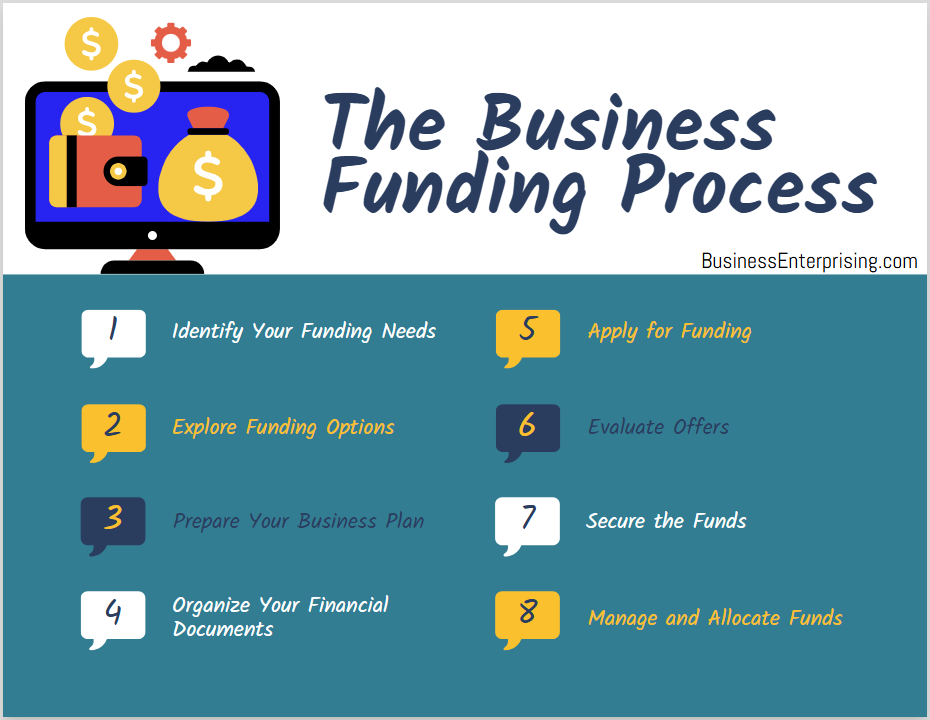
Additionally, understanding the different types of funding options allows you to choose the one that best suits your business needs. From loans and grants to venture capital, each option comes with unique benefits and considerations. Preparing thoroughly with a business plan, financial projections, and organized documentation helps present your business as a strong candidate.
The business funding process doesn’t stop at securing the money. Managing your funds effectively and tracking their impact is just as important for sustaining growth. By focusing on these steps, you can confidently move through the funding process and set your business up for long-term success.
Understanding the Types of Business Funding Options
Understanding the types of business funding options is an essential first step in finding the right solution for your company’s needs. Business loans are a common choice for startups and established businesses seeking predictable repayment schedules. They work well for companies that have steady revenue and a clear plan for how they will use the funds. However, loans often require collateral and strong credit.
Grants are another option, especially for small businesses and nonprofits. Unlike loans, they do not need repayment. However, grant applications can be highly competitive and require detailed proposals. Additionally, venture capital funding is ideal for businesses with high growth potential. Venture capitalists provide funds in exchange for equity, but this option may require giving up some control of your company.
Bootstrapping, on the other hand, relies on personal savings or revenue reinvestment. It allows you to maintain full ownership and avoid debt. However, this option can limit your growth if resources are scarce. When choosing among these options, consider your financial situation, long-term goals, and risk tolerance.
The business funding process can seem complex, but identifying the right option makes it more manageable. Loans work best for businesses with stable income, while grants suit those with specific projects. Venture capital is better for innovative businesses seeking rapid growth, and bootstrapping is ideal for entrepreneurs prioritizing independence. Understanding these choices helps you make informed decisions and set your business on the path to success.
Steps to Prepare for Business Funding
Preparing for business funding requires careful planning and organization. Creating a comprehensive business plan is one of the most important steps. A strong business plan outlines your company’s goals, target market, and competitive advantages. Additionally, it shows potential funders how their investment will contribute to your success. A clear, professional plan builds confidence in your business and its growth potential.
Financial projections are also essential in the business funding process. Lenders and investors need to see accurate forecasts of your revenue, expenses, and profitability. These projections should include best-case and worst-case scenarios. Furthermore, detailing how you will use the funds demonstrates that you’ve thought through the financial implications. Accurate projections help funders understand the return on their investment.
Organizing your documentation is another critical part of preparation. You’ll need to gather important documents, such as tax returns, balance sheets, and proof of ownership. Additionally, create a concise funding proposal that summarizes your request. This proposal should clearly explain how the funds will support your business goals. Having everything prepared in advance shows professionalism and increases your chances of approval.
The business funding process can be complex, but preparation simplifies it significantly. By developing a strong business plan and clear financial projections, you’ll present yourself as a credible candidate. Additionally, keeping your documentation organized ensures you can respond quickly to funder requests. Proper preparation not only streamlines the process but also improves your chances of securing the funding your business needs.
Navigating the Application Process
Navigating the application process for business funding requires attention to detail and careful preparation. When completing loan applications, it’s essential to provide accurate and complete information. Double-check all financial figures and contact details to avoid errors. Additionally, tailor your responses to highlight how your business meets the lender’s criteria. Presenting yourself as organized and knowledgeable increases your chances of approval.
When pitching to investors, focus on clarity and confidence. Clearly explain your business model, funding needs, and growth potential. Use visuals or data to support your key points. However, avoid overwhelming your audience with too much information. Additionally, practice your pitch to deliver it smoothly and anticipate potential questions. Engaging with your audience shows preparation and professionalism.
Avoiding common mistakes can streamline the business funding process. For example, incomplete applications or missing documentation can lead to delays or rejections. Therefore, review all requirements carefully before submitting. Additionally, be honest about your financial situation to build trust with funders. Overstating revenue or minimizing risks can harm your credibility if discrepancies are discovered later.
By following these tips, you can confidently approach the business funding process. Providing accurate information and avoiding common pitfalls demonstrate your readiness to secure funding. With preparation and attention to detail, you increase your likelihood of success in obtaining the financial support your business needs.
Evaluating Loan Terms and Funding Offers
Evaluating loan terms and funding offers is a critical step in the business funding process. Interest rates are one of the most important factors to review. Higher rates increase the cost of borrowing and impact your overall financial planning. Additionally, consider repayment terms carefully, including the length of the loan and payment schedule. Shorter repayment periods reduce overall interest but may result in higher monthly payments.
Understanding equity stakes is also essential if you are pursuing investor funding. Equity-based offers require giving up a portion of ownership in your business. While this can provide valuable resources and expertise, it also means sharing control and profits. Therefore, evaluate whether the trade-off aligns with your long-term goals. Consider how much ownership you are willing to share and whether the investor’s involvement adds value.
Additionally, take time to review the fine print in any agreement. Terms and conditions often include details about fees, penalties, and other obligations. For instance, some loans may have prepayment penalties or hidden charges that affect your financial flexibility. If you are unsure about specific clauses, consider seeking professional advice to clarify the implications. Understanding these details helps you avoid unexpected surprises later.
By carefully evaluating loan terms and funding offers, you can make informed decisions that support your business goals. Reviewing interest rates, repayment terms, and equity stakes ensures you select an option that fits your needs. Additionally, understanding the fine print protects you from unnecessary risks and strengthens your position in the business funding process.
Common Challenges in Securing Funding and How to Overcome Them
Securing funding can be challenging due to factors like credit score issues, lack of collateral, or high competition for grants. A low credit score often raises red flags for lenders, making them hesitant to approve your application. However, you can address this by reviewing your credit report and resolving errors or outstanding debts. Additionally, building a history of timely payments improves your creditworthiness over time.
A lack of collateral can also hinder your business funding process, especially when applying for secured loans. Lenders may require assets like property or equipment to back the loan. If you don’t have collateral, consider exploring unsecured loans or alternative funding sources like grants or crowdfunding. Additionally, presenting a strong business plan and financial projections can sometimes compensate for the absence of collateral.
High competition for grants makes it challenging to stand out among applicants. To improve your chances, tailor your application to meet the funder’s requirements. Clearly articulate how your business aligns with their goals and provide detailed examples of the potential impact. Additionally, seeking professional assistance in drafting your proposal can make your application more compelling.
Overcoming these challenges requires preparation and a strategic approach. Improving your credit score and resolving potential issues in advance increases your chances of approval. Additionally, exploring alternative funding options and tailoring your applications show funders you are serious and prepared. By addressing these obstacles proactively, you can navigate the business funding process with confidence and improve your success rate.
Sustaining Growth After Funding
Sustaining growth after securing funding requires careful planning and effective management of resources. Allocating funds strategically ensures your business meets its short-term and long-term goals. Start by prioritizing key areas like operations, marketing, and product development. Additionally, reserve a portion of the funding for unexpected expenses or opportunities. Clear priorities help you avoid overspending and maintain control over your finances.
Tracking spending is equally important for ensuring accountability and achieving a return on investment. Regularly monitor your expenses using detailed records or financial software. Additionally, comparing actual spending to your budget highlights areas where adjustments may be necessary. Consistently reviewing financial performance helps you stay on track and avoid costly surprises.
Focusing on measurable results is critical for maximizing the value of your funding. Track key metrics like revenue growth, customer acquisition, and cost efficiency to assess your progress. Additionally, align spending with initiatives that directly support these goals. Evaluating the impact of each investment ensures you are using funds effectively and achieving a meaningful return.
The business funding process doesn’t end with receiving the money. Effective management and tracking allow you to build on your success and sustain long-term growth. By staying disciplined and aligning resources with your goals, you can make the most of your funding and support your business’s continued success.
Conclusion
Securing funding is a significant milestone, but managing it effectively is equally important for long-term success. The business funding process equips you with the resources to grow, but it also requires careful planning and execution. By understanding your funding options and preparing thoroughly, you can approach this process with confidence.
Additionally, evaluating loan terms or funding offers ensures you make informed decisions that align with your goals. Navigating challenges and tracking progress after receiving funding keeps your business on track for sustainable growth. These steps help you maximize the value of your financial support and avoid unnecessary risks.
Ultimately, the business funding process is about more than obtaining money. It’s an opportunity to build a stronger foundation for your business’s future. By staying focused, organized, and adaptable, you can turn funding into a powerful tool for growth and continued success.



